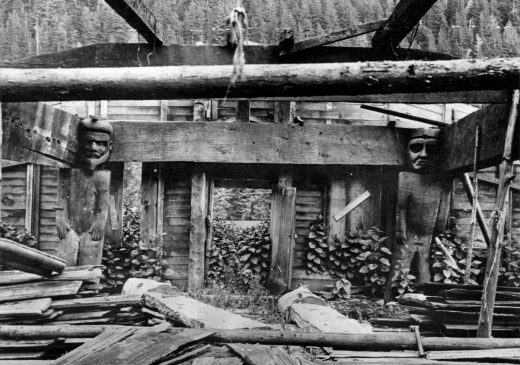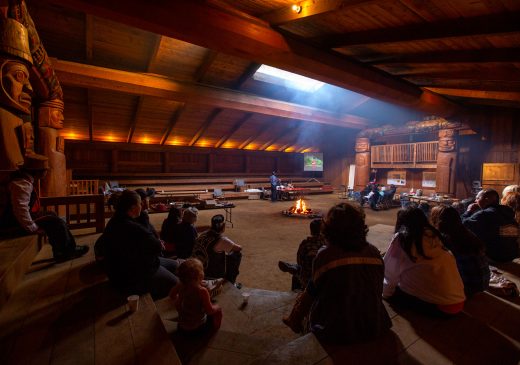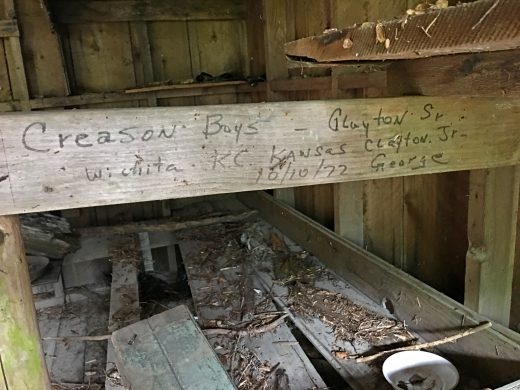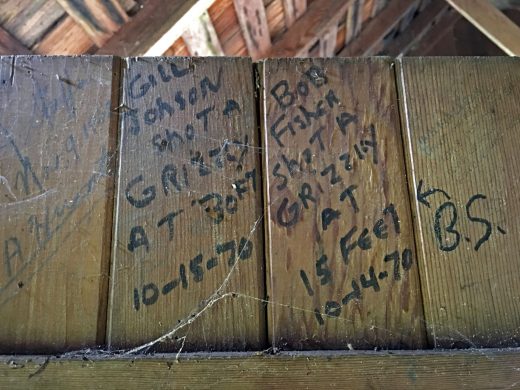In the Kingdom of the Bears
The human-bear bond is ancient, but across the northern hemisphere, only a few societies remember the art of neighboring bears.
Article body copy
This article is one in a three-part series that explores reconciliation with Canada’s Indigenous people through reinvigorating control and access to resources. The others are “Of Roe, Rights, and Reconciliation” and “Deer Wars: The Forest Awakens.”
A snuffling and snorting outside my tent stirs me awake. I sit up, feel for my bear spray, and try to recall my surroundings. My tent is just one of several, and the food is locked in an old trailer down a path through the scrubby trees. The only other sound is my breathing—until a sharp bang from someone hitting a pot splits the air, shooing away our midnight visitor in a calm, firm voice: “Yau ‘thà. [Hello, black bear.] Go on now. Not tonight, thank you.”
I lie back down, and as sleep drifts toward me, my subconscious chides me awake: “There’s toothpaste in a bag by your feet.” Damn, so much for a bare campsite in bear country. I’m over 400 kilometers northwest of Vancouver and a two-hour boat ride from the nearest human outpost, the Wuikinuxv Nation’s village on British Columbia’s central coast. Night one of a three-day camping trip in the nation’s territory—a place that’s pretty much Kingdom of the Bears—and already I’ve failed to consider the furrier beings on the landscape. Any bear within a few kilometers would have smelled our arrival. Once in their midst, a curious odor—even toothpaste—may beckon a sensitive snout.
I tuck my toothpaste—and the face cream and sunscreen I find with it—into a dry bag and shove it outside my tent. In reality, that will do little to keep the bear from coming back to investigate if it’s interested in my lotions and potions. The gesture also does little for my self-reproach—when living with bears is an occasional thing, it’s easy to forget the little courtesies necessary for sharing space. The art of neighboring bears has to be practiced.
After the sun rises, I join people shuffling to the campfire in varying degrees of alertness, by ones, twos, threes, lured by the aroma of camp coffee and the warmth of the flames; it’s mid-June but still chilly in the morning. The kids show up about an hour later than the adults, descending in an alarmingly awake unit of 12 and perking up even more when they smell pancakes. Most of the 35 people in the group—parents, grandparents, aunts, uncles, and children—are from the Wuikinuxv [Oh-weh-KEEN-o] and Haíłzaqv [Heiltsuk] Nations. The scientists studying bears in Wuikinuxv territory collaborated with the community to organize the trip. It’s a gesture of reciprocity, an act of appreciation for sharing place and knowledge, a teaching opportunity for the youngest.
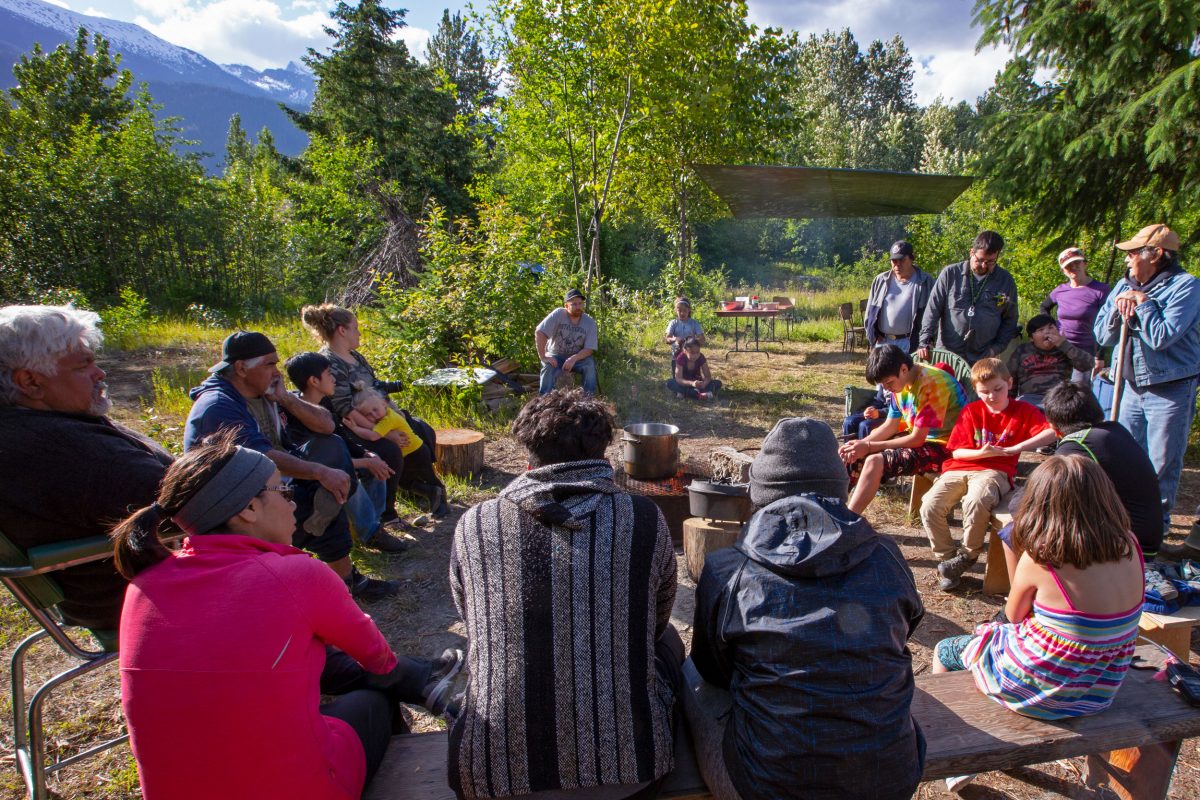
A group from the Wuikinuxv and Heiltsuk Nations spends time in the backcountry on the British Columbia coast sharing stories and experiences. Photo by Grant Callegari
We talk about who heard the bear. Brittany Shillingford, a teacher at the Wuikinuxv school, hadn’t heard our ursine neighbor. But just before bed, she had her closest encounter ever when she saw a black bear, possibly our nocturnal snoop, loitering next to her tent.
It’s a good time of year to hunt black bear, says Xvu’sem’da’as Ted Walkus, a hereditary chief of the Wuikinuxv Nation, explaining that black bears taste best in spring and early summer. That’s when they eat more like vegetarians—heavy into salads, the newly erupted shoots, sedges, and other greens—before they gorge on the salmon running up the rivers. The last black bear Walkus took was two years ago. “I only hunt what I eat,” he says. “[I] made it into 40 pounds [18 kilograms] of burgers and the rest sausage. Oh, it’s good.” He gave the fur to his brother Dwayne Walkus to fashion into a cloak for one of the nation’s ceremonial dances.
The kids dump their dirty dishes into a tub filled with hot water and wander away to play, unperturbed by the bear talk. Although one child leaves gripping a machete.
Of North America’s two southern bear species—black and brown—brown bears loom large in most Indigenous cultures. To some biologists, grizzlies are a brown bear subspecies; to others, they are just North America’s version of brown bears. Brown bears lingered in Beringia before migrating south over 20,000 years ago. They are one of the few large land mammals to survive a changing climate and a blitzkrieg of hunting that began as humans moved across the continent from coastal Alaska through British Columbia, likely on the bears’ heels. As they trekked, humans and bears inventoried their surroundings, assessing the territory for food, shelter, and safety. They would have been aware of each other and of the two other bear species already here: the black bear and the fearsome, now-extinct, giant short-faced bear, which was one and a half times as tall as the grizzly. The humans may have felt some relief heading into established bear land: bear habitat is, after all, human habitat.
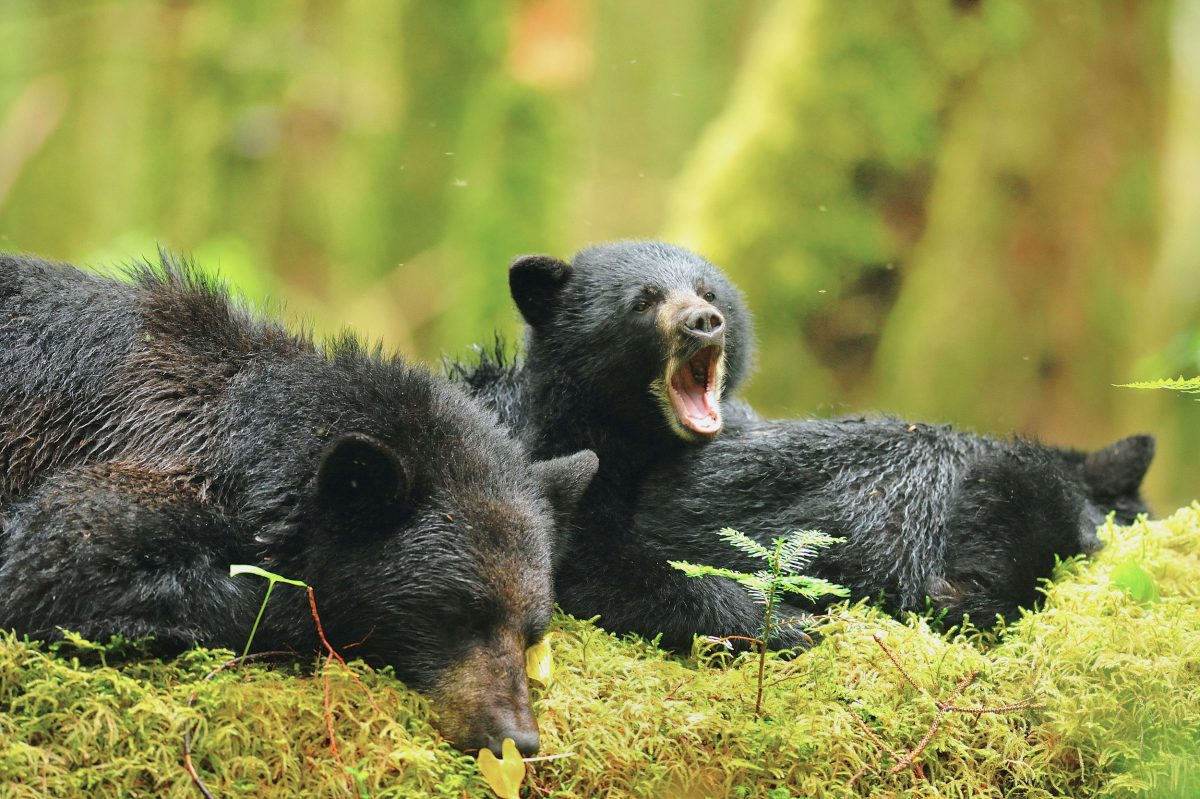
With permits, big game hunters can still bag a black bear in British Columbia. Black bears predate grizzlies in North America. Photo by Fabrice Simon/Minden Pictures
We’ve set up camp on Wuikinuxv Lake, on a stretch of land that juts into the water. Called Second Narrows, or Sumaxalh in the W’uik’ala language, the point is near an old village site in the backcountry, a place wild with life—a land of berries and fish and trees. It’s a place to hunt and trap and strip bark from red cedars for weaving into hats and baskets. The human occupation of this spot stretches from over 13,000 years ago to just a decade or so ago when a work crew left a logging camp for the last time. We sit around the fire engaged, like so many before us, in the ancient practice of swapping bear stories.
Over the next few days, another bear and human story will unfold. The story is modern, cradled in a shared past few of us recall.
Along the path from the dock, a small figure ambles toward the campfire. Nuuwagawa Evelyn Windsor, an elder, has arrived for the day from the Wuikinuxv village. Amid cries of hello, bodies and chairs shift as we all vie to offer the 89-year-old the most comfortable spot.
Windsor and her little brother Danny Walkus, Ted’s father, were probably the last babies born here at the lake. Not at this exact spot. “A little up the lake that ways,” she says, waving her hand. She remembers the other kids, cozy nights in the big house, her auntie and uncle’s lean-to. For countless generations, Windsor’s birthplace was a warm-weather home, where people decamped before winter to canoe to a village closer to the sea along the Waanukv [Wannock] River, a short, turbulent, fluid foyer connecting Wuikinuxv Lake to the ocean. “There used to be hundreds of people long ago,” she says, emphasizing the past by stretching out the vowel in the word long. The best guess is a population of at least 10,000 occupying a territory that stretches from the head of Wuikinuxv Lake to Koeye River to Cranstown Point, before the English and Spanish sailed to this edge of the continent. The grizzly population at the time is a mystery but was certainly higher than today’s.
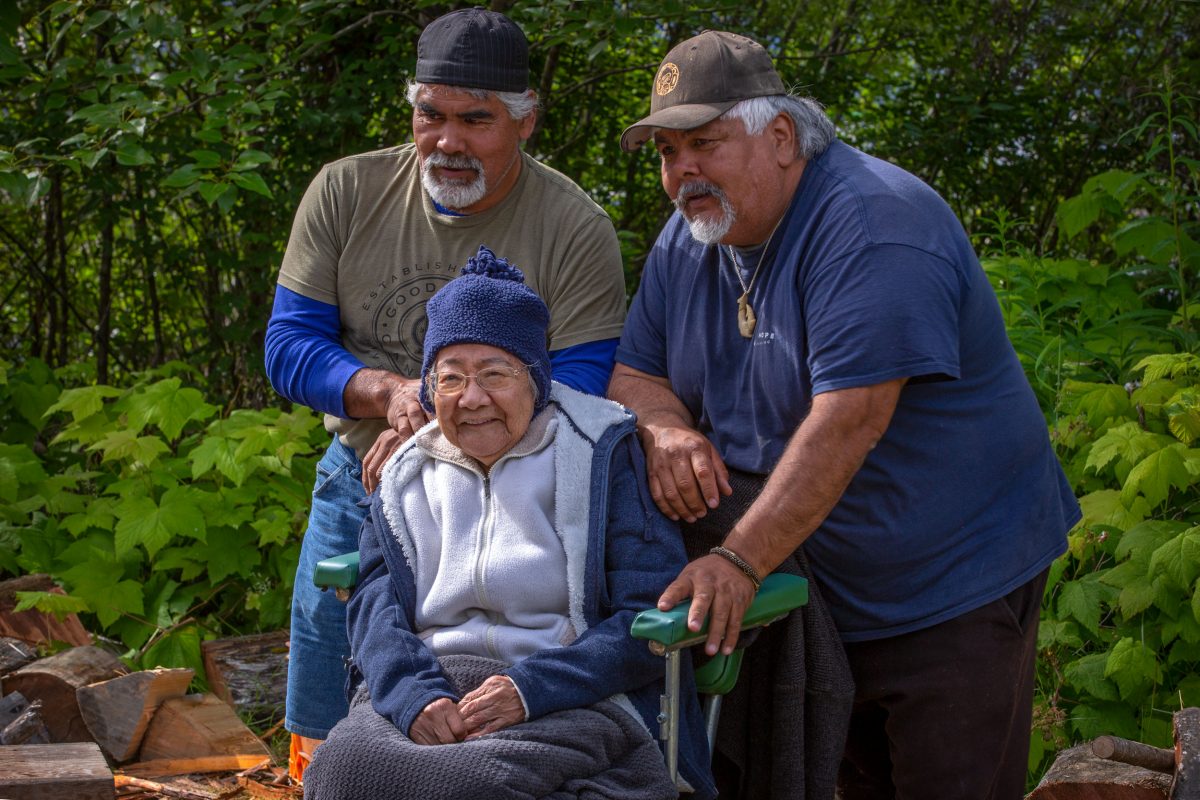
Ted Walkus, right, his brother Dwayne, and their aunt Evelyn Windsor, a Wuikinuxv elder and cultural treasure at Second Narrows, near Windsor’s birthplace in Wuikinuxv territory. Photo by Grant Callegari
People and bears moved systematically, in tandem, from sea to river to lake, from one seasonal home to the next—hauling salmon from the nine spawning streams that feed the lake in fall, or heading up to harvest berry patches in the bush in summer. To imagine Windsor’s ancestral home, we have to gaze beyond the abandoned portable trailers the loggers left behind, their names written on doors with a Sharpie, and the baby-blue Chevrolet pickup, license plate BN 9745.
Steps away from the wisps of campfire smoke, mingling with the fresh tang of the lake, is an aromatic reminder of this most recent invasion—the sweet smell of cottonwoods. The light-craving cottonwoods flourish in the open spaces left by logging, free from the shadows of hemlocks, cedars, and firs. From an airplane, the opportunistic cottonwoods erupting on former logging roads resemble bright green ribbons winding through the dark conifers draping the mountains. Until January 2017, this place was commercially part of the Mid Coast Timber Supply Area, which—ecologically—is part of the planet’s largest coastal temperate rainforest.
In the late 1990s, groups of environmentalists and First Nations challenged timber companies and the provincial government over logging of the region’s old trees. At the height of the campaign, protestors congregated at Canadian embassies in Europe, outside the offices of logging companies as far away as Japan, and at retailers at home and abroad, including Home Depots across North America, triggering a widespread boycott of paper products from British Columbia’s old-growth forests. A 20-year negotiation between the four parties led to the protection of a 64,000-square-kilometer stretch of rich coastal habitat for bears and their entourage: the Great Bear Rainforest (GBRF). The name was adopted from the protesters’ lexicon, a genius stroke of branding.
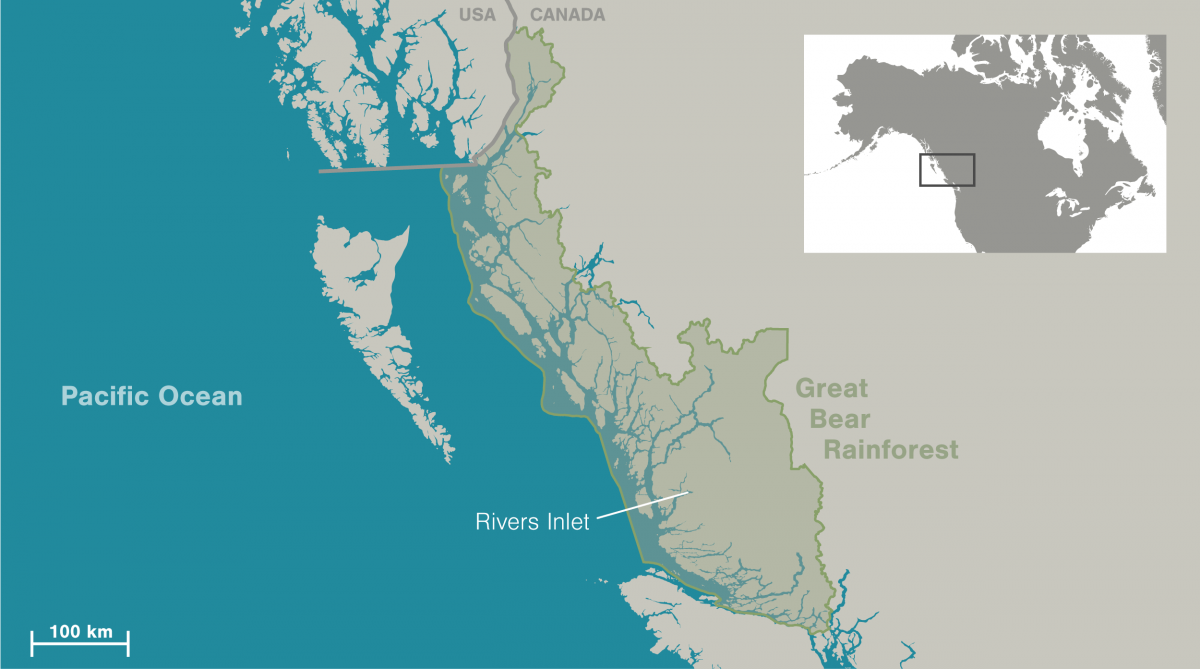
Wuikinuxv territory lies within the Great Bear Rainforest, which covers 6.4 million hectares on British Columbia’s north and central coast, about the same size as Ireland. Illustration by Mark Garrison
Bears were the perfect animals to universally capture the public’s heart, especially the spirit bear—a white-phase black bear—which became the wild face of the campaign. As a mascot, this rare phase of bear so rooted in place was a testament to the GBRF’s singular status in our planet’s diminishing wilderness. Activist Tzeporah Berman explained the name in her 2011 memoir, This Crazy Time: “We needed a name that immediately defined the area. We wanted people to hear the name and be mad as hell that anybody could turn it into toilet paper.” Once handed that perspective, the imagery of bears versus ass-wipes is tough to shake.
The final agreement, signed last year, pushes beyond protecting trees and habitats: it acknowledges Indigenous rights. The GBRF encompasses 26 First Nation territories, and each nation will take part in making decisions related to the region. (Of course, paper agreements and reality have ways of parting company, and not every nation is happy with the outcome.)
All of the Wuikinuxv Nation’s traditional lands lie within the protected boundaries of the GBRF. Today, the nation numbers around 300 with just 40 to 60 at any one time living in the village on the Waanukv River. The grizzly population dwindled over the years too, yet the lives of the two species remain intertwined. For the most part, however, there are no cyclical movements of the human community through the territory as in the past—people have school and work, and heading out on the land is expensive—but grizzlies continue to cruise through the usual haunts in search of food, shelter, and safety.
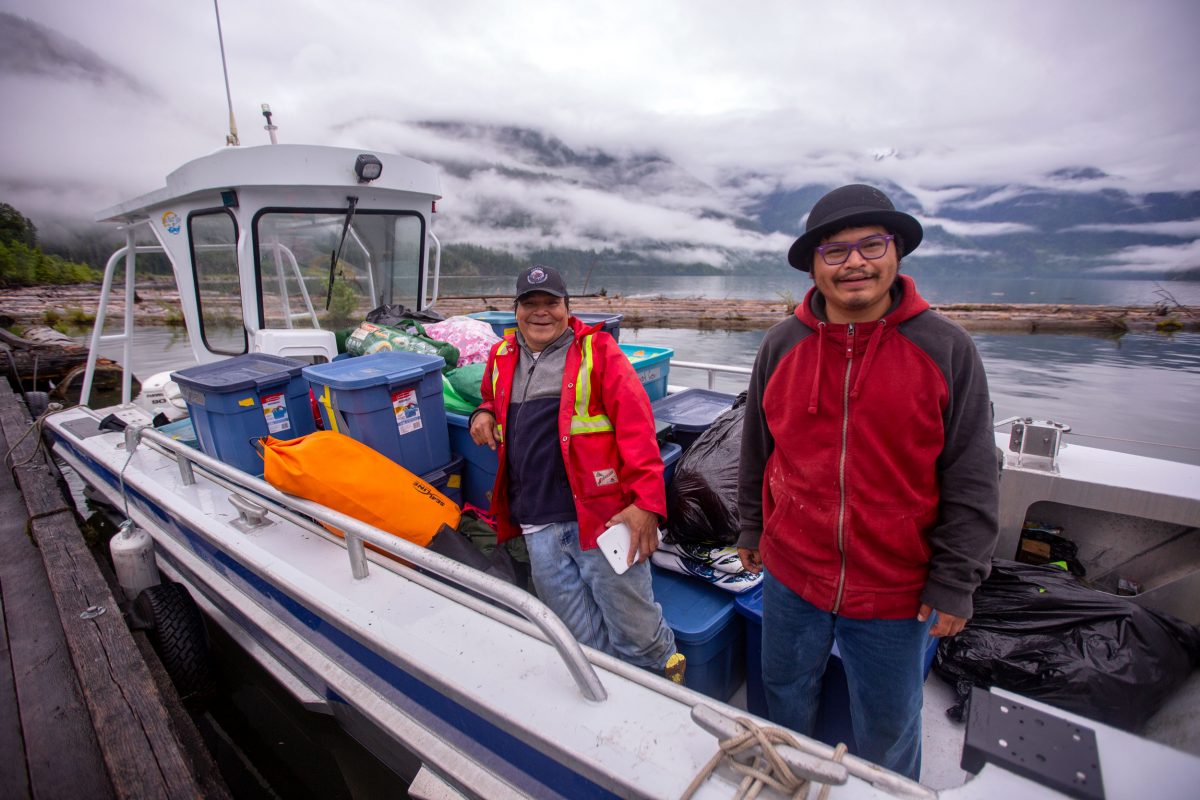
Patrick Johnson, left, and Alec Willie are Wuikinuxv Coastal Guardian Watchmen, part of the region’s environmental stewardship program, which provides financial and logistical support to the bear project. Wuikinuxv Guardian Watchmen also assisted the community with the camping trip to the backcountry. Photo by Grant Callegari
This camping trip is short but it’s part of a revival, a passing on of knowledge—bear neighboring etiquette, for example—to the younger generation, those kids now scattered about the camp immersed in a game of hide-and-seek or hacking at cottonwoods with the machete. Like bear cubs and other animals with extended childhoods, kids play to practice how to live in the world, learning by testing themselves.
A couple of generations ago, parents and grandparents spent more time in the forest with the kids. Over 50 years ago, some of the people sitting around the fire, including Windsor’s progeny, were lucky enough to spend summers here with family. And, in the way Torontonians in a city thick with human garbage all have raccoon stories, they all have bear stories from a place thick with a major ursine attractant—salmon.
Ray Johnson’s first memory of seeing a grizzly was around age five on a trip up the lake, and he remembers being scared. “He was really mad,” Johnson says, emphasizing the last word and raising his arms to mimic an alarmed bear standing up to better assess any danger.
Dwayne Walkus prepares a salmon for dinner at the Second Narrows camp. Video by Jude Isabella
Johnson is the only person I’ve ever met who authentically chortles and guffaws. His default mood is merry and his glee palpable, his body moving to the tune of his own laughter. That’s very bear-like if you believe one bear behavior researcher who described bear laughter as a whole-body movement. Johnson’s chuckles of delight are an expression of equal parts wonder and amusement as he recounts his other run-ins with grizzlies: when he and a gaggle of screaming kids playing tag in the village were startled to come across a grizzly, and the equally startled grizzly dove into the water off a boat dock to get away from them; and the time he was walking back to the village in the dark after a fishing trip, and a grizzly swiped the coho hanging off his pack. But the most astonishing was the grizzly that thundered over the cab of a pickup backed up against his cousin’s porch. The massive bear—just a bit smaller than a Fiat 500—grabbed a freshly caught halibut that had taken four grown men to lift into the truck’s bed, and held the fish in its maw as easily as a human holds a harmonica.
But Johnson has another story, about his transformation into a grizzly.
At age four, Johnson’s aunt dressed him in kid-sized, kid-friendly dance regalia—a small blanket, an apron, and a headdress. He was nervous, but he danced as he was taught and had practiced. Four times he circled the gathering hall as elders watched him, a knee-high embodiment of a grizzly. After the dance, the elders gave Johnson the name naan,[grizzly bear], permission to perform the dance for a winter ceremonial dance series called `Caiga; and a hereditary chieftainship. Johnson recently passed on the dance and the name to his son Billy. “It’s for someone younger,” he says. The bear-human bond moves on to another generation.
The bond between humans and bears has depth and breadth, predating any of the ancient religions known today, perhaps for one very good reason: when our ancestors left their homeland and spread to higher latitudes some 60,000 years ago, the most humanlike nonhuman beings they encountered were bears. None of our hominid cousins, apes, shared these new territories.
About a half million years ago, the brown bear emerged in Asia and began its march across continents. As humans spread into Eurasia, Homo sapiens came to dominate most bear habitat, possibly to the point of driving the brown bears’ relatives, cave bears, to extinction through homelessness. In a gentrifying kind of move, humans appropriated the best caves starting about 40,000 years ago.

The Wuikinuxv village is almost 500 kilometers northwest of Vancouver, British Columbia, and is accessible only by boat or floatplane. Illustration by Mark Garrison
Despite the human footprint on their habitat, most bears thrived. Diverse Homo sapien societies have typically acknowledged bears as something both divine and familial. Especially brown bears. In Siberian cosmologies, brown bears descended from humans or were the offspring of heroes and forest sprites. In Japan, the Indigenous Ainu have revered brown bears and raised cubs as children for thousands of years. Both English and Danish aristocrats claimed descendancy from brown bears, and in Celtic lore, a princess bore three children with the Brown Bear of Norway.
What could possibly have the power to disrupt a relationship so rooted in our collective psyche for so long and across cultures? What could threaten the brown bear’s survival among us, once an existence guaranteed by its position as sacred and deserving of reverence? A new god.
Numerous scholars routinely credit Christianity with uprooting old traditions that once defined a people by overwriting their stories with new ones. The success of Christianity is often attributed to the canny reworking of traditional practices and stories, infusing them with a Christian ethos. As far back as the fourth century, for example, Jesus’s disciples tamed the magical, powerful, fierce bear of pagans into a life-giving and protective force. In that era, explain Paul Shepard and Barry Sanders in The Sacred Paw, a bear’s “fart of dehibernation” was interpreted as the breaking wind that announced the blessed arrival of spring and the resurrection of life after the dead of winter. That’s the bear story spun by the patron saint of Candlemas, the Christian festival of light celebrated on February 2, when the bear would hopefully emerge from its den.
Even as their spiritual grip on most human cultures in Eurasia loosened, brown bears had the tenacity to physically hang on for a while. Browns are the widest ranging of bears, adaptable to all kinds of habitats and foods. As famous naturalist John Muir wrote, “to [the grizzly bear] almost everything is food except granite.” Despite centuries of coexistence and burgeoning human populations, it wasn’t until the 1500s that brown bears were squeezed out of Egypt’s Sinai Peninsula, and they hung on in Morocco and Algeria until the 1800s. A couple hundred brown bears still ramble around Greece, much as they did when the Greeks believed that Zeus cast Callisto—his human lover who was turned into a bear by a jealous Hera—into the sky to form the Great Bear constellation. These days, Greek bears are more likely to be a victim of a hit-and-run. So much for the commandment love thy neighbor as thyself.
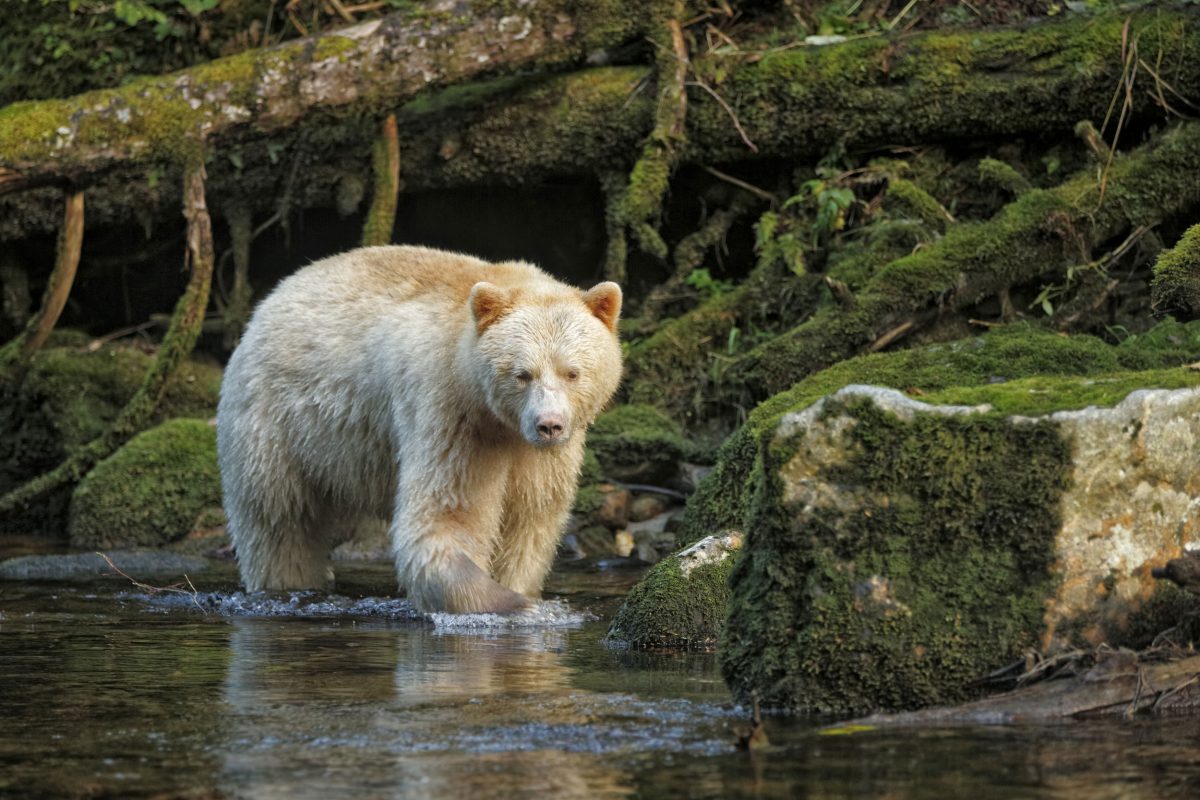
The spirit bear of coastal British Columbia is sometimes spotted as far south as Wuikinuxv Lake. Photo by Ignacio Yufera/Minden Pictures
Indigenous America’s traditional perspectives on brown bears have much in common with ancient Eurasians’. The spirituality and earthiness of bear-human liaisons is echoed across North American Indigenous cultures and, despite widespread conversions to the Christian faith, many continue to embrace bears as metaphysical beings and accept that sacredness also lies beyond the church. Windsor underscores how the Wuikinuxv were confident in their traditional ways of spirituality when she shares that missionaries once deemed the Wuikinuxv as “unconvertible,” and that their rebellious nature eventually led them to burn down the village church. “They never rebuilt it,” Windsor says, recounting the anecdotes in Ted’s motorboat, part of a flotilla scooting toward a beach at the head of the lake, a dark, wavy mass within the firm embrace of white-capped mountains.
The last time Windsor was up this way was eight years ago, and she responds to the shoreline and the mountain peaks zipping by with a smile of contentment, the kind you wear when you’re finally home after a long while away. “My dad used to say that glaciers were history keepers,” she says over the sound of the motor. A linguistic consultant for decades, Windsor has authored scholarly papers on central coast languages and a teachable moment is irresistible: she sounds out the W’uik’ala word for these icy historians—ooyenglees.
Ted points to a place on the shore. “This is where my grandparents’ cabin used to be,” he says. “You can see the old cherry trees.” Windsor describes how a beach across the way once looked as if it were moving. “There were so many frogs,” she says, pensive as she gazes. “So many memories.” She is a small woman, made more slight within her bundle of blue—toque, fleece jacket, and quilt tucked around her legs—yet mighty in her resilience. Ted calls his aunt the community’s security blanket, her memory a living guidepost to a robust Wuikinuxv culture.
As we near our destination, Ted tells me a bear story that says a lot about the intrusion of external stories into our mental landscapes. The first place Ted saw a spirit bear was here at the head of the lake when he was a boy. Until grown-ups set them straight, he and his cousin Patrick thought they had seen a polar bear since the only place they’d seen white bears was in National Geographic.
We hop out of the boats onto a little beach. The kids hit the sand running, already at play. They splash in the water, laughing and screaming. They bury one good-natured soul up to his neck in sand.
One woman heads to a cedar shack that’s capped with a sagging, mossy roof. Nestled within the emerald branches of cottonwood, hemlock, fir, and cedar, the cabin is a relic from the decades before the 1970s, when salmon was so abundant here that government fisheries built cabins along spawning streams for researchers studying and counting fish. Nege’ga Gloria Walkus-Brotchie snaps photos with her phone. Flourishing a Sharpie, she gazes at a wood wall, any sheen it once had dulled by time, chooses a spot, and adds her name and the date, a defiant gesture amid the many names, dates, and comments scrawled decades ago by big game hunters.
In the cabin at the head of Wuikinuxv Lake, Gloria Walkus-Brotchie adds her name to a crowd of signatures from big game hunters, hikers, and others who trekked by over the years. Video by Jude Isabella
The cabin’s history and signatures are reminders of a fundamental problem that arises when the value of the natural world is abstract to some and concrete to others. With money to be made comes the classic tug of war between short-term gain and long-term loss. The commodification of grizzlies legally ended last year, when the province of British Columbia finally closed a hunt they had begun marketing over a century ago.
Look back through the archives of the Daily Colonist, the newspaper from British Columbia’s capital, Victoria, and it’s clear that government and businesses have forever flogged fishing and big game hunting. An article by the provincial game warden in 1909 outlined how visitors could legally hunt or fish for a whole year, starting in late August and moving from one animal to the next, advising them to wait until spring to hunt bears when their fur was most luxurious. In 1913, Oscar Chapman Bass, a Victoria lawyer, represented both the game department of the provincial government and the publicity branch of the Canadian Pacific Railway at the Canadian Camp, an outdoors club in New York City. He brought bear pie. He flattered the New Yorkers—“So friendly!”—and went over his allotted 20 minutes of speechifying to extoll the glories of the province (the government had debuted the tagline “The last place God made” that year) and its amazing hunting opportunities. One could, Bass said, repeating the game warden’s words, spend an entire year legally hunting and fishing in the province, hopping from one open season to the next.
Bass may as well have said: come kill our bears because you don’t have any.
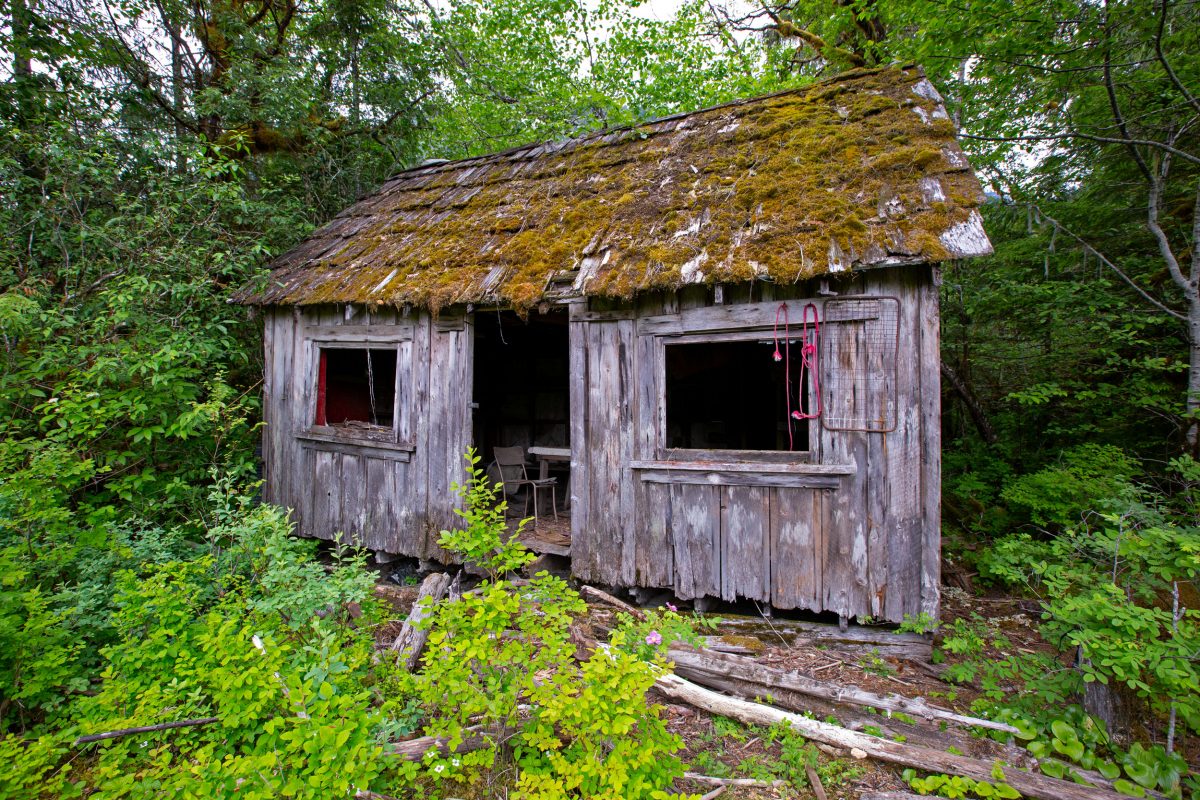
Hunting guide Clayton Mack brought clients to this old cabin at the head of Wuikinuxv Lake. Photo by Grant Callegari
As ranchers and hunters expanded across the American West, eradicating grizzlies and other predators to protect livestock, they created a paradox for themselves: they’d rid themselves of nuisances, but they still yearned to hunt them. By 1913, grizzlies were nearly wiped out in the continental United States. The historical population is iffy, but bears were ubiquitous throughout Western Canada, western and central United States, and northwestern Mexico until the 1900s. As Texas ranchers expanded their cattle herds from 100,000 animals in 1830 to over 3.5 million in 1860, the grizzly population sank: the last grizzly in that state was killed in 1890. And so it went state by state: California saw its last grizzly in 1922, Utah in 1923, Oregon in 1931, and Arizona in 1935. Northern Mexico’s last recorded grizzly was in 1962.
As we scan the names on the old cabin wall, Walkus-Brotchie tells us about legendary guide Clayton Mack of the Nuxalk Nation in Bella Coola—70 kilometers from here through the mountains—who brought clients to this cabin. Bears were one of the many resources outsiders were taking from the land, and guiding was one of the few ways for Mack and other Indigenous people to make money in the new economy.
We move from wall to wall reading entries: “The Creason Boys Wichita, KC Kansas 10/10/72,” “Don Snizik shot a grizzly 10-13-70,” “Bob Fisher shot a grizzly at 15 feet 10-14-70,” to which someone drew an arrow with, “B.S.” In his 1993 book Grizzlies & White Guys, Mack shares stories of hunters acting as if they’re in scenes out of a Marx Brothers movie, if the Marx Brothers ever made a grizzly hunting movie. Many were terrible shots. Mack regularly chased wounded bears to finish them off. Clients never listened to him, except for one teenage girl who listened and was very good at bagging bears. German hunters were happy with a black bear; Americans wanted a trophy, nothing less than a Boone and Crockett-worthy grizzly, preferably picked off from a boat. I wonder if the lazy hunter Mack guides and complains about for a few pages is the one memorialized with “Rodney slept here + slept here + slept here! 9/2-6/73.”
Big game hunters left their marks on the cabin walls. Photos by Jude Isabella
Time and again, Mack brought clients to this lake and the many rivers that feed it, as well as the nearby Kwatna River estuary. He knew where the bears were. It’s no different today. In fact, 20 years after Mack’s death, it was at the Kwatna estuary where an NHL player illegally shot and killed a grizzly in 2013, causing an uproar heard across borders and refocusing the public’s attention on British Columbia’s trophy hunt.
Measuring the health of a grizzly population depends on geography and lens. In British Columbia, grizzlies are listed as vulnerable; in Canada, they’re a species of special concern; and the International Union for Conservation of Nature lists brown bears as a species of least concern, meaning that globally, they are doing just fine.
Take one species, place it in multiple jurisdictions, and confusion ensues.
Worldwide, brown bears number around 200,000, half of which inhabit Russia. According to government officials, North America has 60,000 brown bears: 70 percent live in Alaska and 25 percent in British Columbia. But population counts are disputed, and coastal First Nations have long complained that British Columbia estimates rely on flawed data. An October 2017 report from the province’s auditor general agreed; a key finding was that the province lacked an organized inventory and a monitoring strategy for grizzly bears.
What Jennifer Walkus, Windsor’s niece and a member of the community’s bear working group, is clear on is that Wuikinuxv territory has one of the densest grizzly populations in the Great Bear Rainforest. How many grizzlies and black bears call the territory home will be revealed when the Wuikinuxv complete their own population count.
Numbers aside, it’s heartbreaking when outsiders shoot your neighbors for fun. Or when your neighbors starve to death around you.
As a child, Windsor rarely saw bears. “They didn’t really come around near the house,” she says. “It’s just recently that we’ve been running into them all over the place.” Once the neighborhood changes, when fish and trees disappear, for instance, a bear just looking for life’s basics—food, shelter, and safety—is bound to collide with people, who are generally very good at acquiring all three.
Wuikinuxv elder Evelyn Windsor talks about living with bears, in the past and present. Video by Grant Callegari, Jude Isabella, and Katrina Pyne
The starkest example of the collision dates to 1999, when, after years of decline, the lowest number of sockeye salmon ever recorded returned to Rivers and neighboring Smith Inlets. Combined, the two inlets regularly exceeded two million returning sockeye each year from 1900 to 1974. But by the final year of the 20th century, only 10,157 fish returned to the systems, and just 3,500 or so came to Rivers Inlet.
Back at the camp after our boat ride, as we sit around an afternoon fire, Jennifer tells a sad bear story. “They were starving,” she says of the bears during that desperate year when even mothers with babes, not hardy yearlings, materialized out of the bush and into the Wuikinuxv village. One of the most jarring incidents was caught on video: a mama grizzly, too exhausted to defend herself and her cubs, did nothing as dogs snapped and snarled at the trio, getting close enough to bark in the cubs’ faces. Desperate bears were breaking into buildings and homes. That’s when the people felt as if they had no choice—they had to shoot the bears.
Frank Hanuse, a Wuikinuxv elder and crack shot, killed six of the 14 bears in the village that year with his 12-gauge shotgun. Conservation officers trapped the other eight, though they ultimately died too. The bodies ended up in the dump. “The claws and hides, they were in pretty bad shape—mangy, emaciated,” Hanuse says, adding that someone collected fat from three carcasses but could only fill about half a cup. No one knows how many starving bears died in the bush that year.
The community was so upset, their anguish over killing animals searching for life’s basic needs lingers almost 20 years later. “After all that, we were much more concerned about preserving bear life,” Jennifer says, and the community made plans to adapt their behavior to avoid habituating bears.
Wuikinuxv elder Frank Hanuse talks about the salmon collapse and its effect on bears in the territory. Video by Grant Callegari, Jude Isabella, and Katrina Pyne
Now, their plan is comprehensive: three times a week, a garbage collector knocks on the doors of the village’s couple dozen homes to pick up household rubbish, the dump is encircled by an electric fence, neighbors alert each other by radio if a bear traipses too close to homes, and any bears in the village are given a wide berth. Dogs—a bear attractant in many communities—can play a role as alarms in remote villages with long histories of coexistence. By minimizing encounters, everyone is safer.
Other ways to support bears take more time, such as rebuilding salmon stocks, which is a long-term goal. A more immediate threat—the grizzly trophy hunt—could be countered with scientific data. “It’s not like [the bears] can speak for themselves,” Jennifer says. “We’re the ones who have to do the speaking for them.”
In November 2017, a newly elected provincial government kept a campaign promise to halt the sport that was deeply unpopular with 88 percent of the BC public in one survey. But it was the coastal nations within the GBRF that laid the groundwork. Over a dozen years ago, the Heiltsuk, Nuxalk, Kitasoo/Xai’xais, and Wuikinuxv came together and championed bears through the media and scientific studies.
Dúqva̓ísla William Housty, a Heiltsuk Nation bear biologist who sits on the Heiltsuk Integrated Resource Management Department board, led the scientific charge in the Koeye watershed, 33 kilometers from the Wuikinuxv village. The Heiltsuk community had recently re-established a presence in the Koeye watershed, and began a summer science and cultural camp for youth. It was the perfect spot to learn more about their kin remaining in the area: the black bears and grizzlies drawn by the Koeye River’s relatively healthy salmon run.
In 2006, Housty and his team strategically placed barbed wire hair snares to capture bear fur for DNA analysis. This helped answer questions about the size of the bear population and territory, as well as how the bears used the landscape and shoreline. After six years of research, the results astounded them.

Barbed wire strategically placed along paths captures bear hair, which allows scientists to analyze DNA and determine bear populations. Photo by Grant Callegari
“We thought that maybe there were a dozen bears that used the watershed,” Housty says. “But it was over a hundred individual bears. Not all necessarily living in the Koeye watershed, but using the watershed. It opened our eyes to the connectivity of Koeye and the surrounding systems.” The area, he says, turned out to be a superhighway for grizzlies.
Housty’s work inspired Chris Darimont, a conservation scientist at the University of Victoria in British Columbia who studied wolves in the GBRF from 2000 to 2007 for his PhD, to return and focus on bears. By 2009, Darimont launched the Bear Project with the goal of understanding the ecological interactions of bears, salmon, and people in the entire region. Supported by a number of individuals and organizations, including the Raincoast Conservation Foundation and the Hakai Institute*, Darimont’s crew collaborated with the Heiltsuk, then expanded and partnered with the Nuxalk, Kitasoo/Xai’xais, Wuikinuxv, and most recently another nation in the GBRF, the Gitga’at. Each community has its own questions, such as the impact of ecotourism or ways to minimize bear-human conflicts. The Wuikinuxv first focused on discovering how many bears share the territory, especially close to their village, and calculating the bears’ salmon needs.
Grizzly density is super high around the village compared to the rest of the Wuikinuxv territory, says Megan Adams, the midnight patroller who shooed away the bear that first night. One of Darimont’s graduate students, Adams collaborates with the nation to help answer their questions. “The story of coexistence with carnivores here is quite strong; [the Wuikinuxv people] don’t even think about the possibility of not coexisting with bears,” she says.
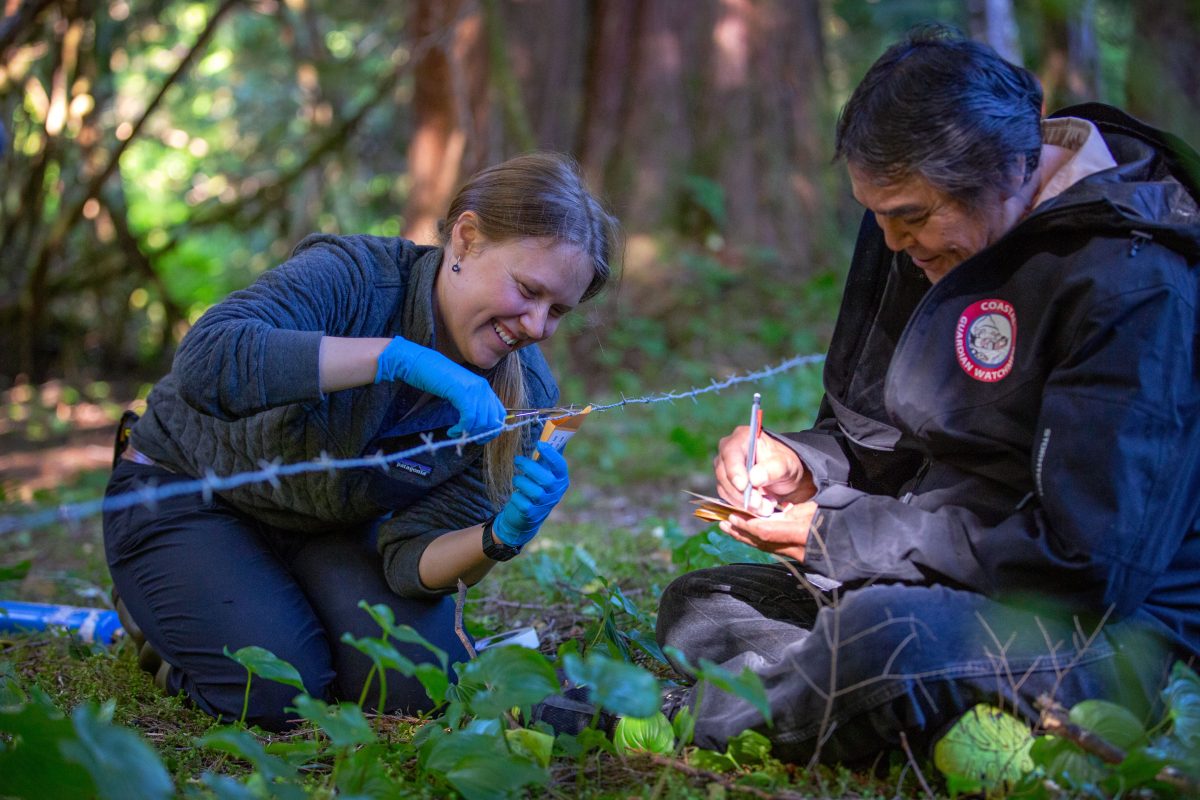
Megan Adams, a bear researcher, and Patrick Johnson, a coastal guardian watchman, collect bear hair samples at a site close to the Wuikinuxv village. Photo by Grant Callegari
The preponderance of bears in the Waanukv River valley—around the village, the lake, and its feeder rivers—makes sense. Grizzlies evolved to exploit the open landscapes left behind by receding glaciers. Their general routine is easy to follow. They leave their dens in the spring, heading downslope to estuaries, rivers, and lake banks rich with new shoots, grasses, sedges, and other greens. Then it’s upslope for berries from summer to early fall, downslope again to fish, and then, to complete their annual cycle, they lumber upslope once more to den for winter. There are variations on this behavior—like people, bears are individuals and idiosyncratic.
Our curious bear, the one that wandered briefly into our camp, is the only bear we hear or see. One morning, Ted and Jennifer take the kids to a spot with red cedars so tall and straight it’s amazing they escaped a fate as urban telephone poles. Jennifer shows us how to strip a tree’s bark for weaving baskets, headbands, and dolls. With enough cedar collected, we meander through the trees, marching up and down a bear stomp trail—a path created by generations of bears stepping precisely into the footprints of the bears that came before them. Some of us look for claw marks or other bear clues. It’s not quite berry season here, which is too bad because to see a heap of bear poop full of spent berries is always a marvel. (A researcher in Alaska once counted 10,000 soapberries in one pile of grizzly scat. There is everything to admire about the researcher and the grizzly—that one species can eat that much and that one had the desire to count that much.)
Jennifer Walkus demonstrates how to strip bark from a cedar tree in Wuikinuxv territory. Video by Jude Isabella
This lush valley bottom, where Windsor and her family once canoed between lake, rivers, and the old villages, is inviting to grizzlies. And today, the Wuikinuxv village itself offers something a little extra to some bears.
If she lives a long life in the wild, about 20 to 25 years, a grizzly mother will have up to 10 cubs, spaced out in litters of one to four. Typically, only half make it through their first year. Newborns are particularly vulnerable; roughly the size of chipmunks, they weigh only as much as a football, and they’re blind and feeble, with little fur to keep them warm.
As spring blossoms, mothers must fret, to consider it anthropomorphically. Emerging into the world with months-old offspring to feed, shelter, and protect is a huge responsibility for any animal. Emerging into the world where cougars and wolves will eat your offspring, and fending off males of your own species that will kill some other male’s cubs for a chance to mate, seems particularly burdensome. If necessary, a grizzly mother defends her cubs to the death; she will fight a large adult male and sometimes die in the process. But she’d rather find safety. And as researchers are finding, a mother and cubs may find that safety close to humans.

Mother grizzlies will ferociously defend their young; here, a grizzly mother chases off another bear in the Great Bear Rainforest. Photo by Jack Chapman/Minden Pictures
Jennifer’s first memory of grizzlies dates to her childhood and chasing them with other kids in the village. “We always got into trouble because—well, it’s a dumb thing to do. You’re chasing a bear!” But a gaggle of noisy kids close to home has never led to conflict. Possibly, within village boundaries with humans big and small yelling, laughing, arguing, and singing, some bears sense safety.
“From what I figure,” Jennifer says, “they don’t want to get kicked out of the village. It’s protection for them, so they try and behave.” And mostly it’s the mothers with cubs that seek safety in human proximity, deeming that risk more acceptable than losing their cubs to predatory grizzly males. It’s an observation Housty, Darimont, and others involved in the Bear Project share, and they point out that moms with cubs are probably drawn to permanent bear-viewing sites established for ecotourism because of the berries and salmon, but they also may come for the safety these sites afford. Mature male grizzlies are more wary of humans. The bears that bother people, Jennifer says, are the teenagers waiting for the next fish run, wandering in and causing trouble. “Because they’re young and dumb, just like we were.”
After the 1999 crash, with bears killed and the dump electrified, bears avoided the Wuikinuxv village. As fish stocks slowly recover, the bears do too, though they’re less bold than before the crash and keep a bit more distance from the community. But still, Adams and her crew found 10 unique individuals, mostly sows with cubs or juveniles, haunting the edges of the village—if anyone is going to see a grizzly, it will most likely be there.
It rains on the journey back to the village. Mist layers the mountains in gauzy stripes as the boats zip along the surface; at least one skipper stops to throw out a line in hopes of catching a fish.
The next day, Jennifer takes me on a hike along the seven-kilometer-long Waanukv River toward an older village site. Jennifer points out cow parsnips—typical bear food—as we head down an overgrown trail. We skirt devil’s club and forge through thickets of shoulder-high salmonberries and knee-high ferns, and scamper over moss-covered logs. A magnificent spruce reaches across the river as if yearning to feel the other side. The air smells green and watery. When alone out here, Jennifer talks to herself to avoid surprising bears. Their presence permeates this place: overturned earth where a bear dug for grubs, the flattened vegetation of a day bed, a rubbing and scratching tree, a bear’s scat.

Jennifer Walkus, a member of the Wuikinuxv Nation’s bear working group, hikes through the woods in the nation’s territory. Photo by Grant Callegari
We push on and the trail disappears so we bushwhack for a couple of hours, edging closer to the river. At one point, hemmed in by brush, Jennifer walks into the river up to her knees to get her bearings. “Oh, my phone!” she exclaims, reaching into her pocket and halting before it’s ruined. Across from where Jennifer stops lies a small island, a winter home for the young Windsor, the old village of Kítit. We continue on, looking for crab apple trees, an easy-to-spot clue that the old village site is nearby. At one point, we’re caught in a prison of brush and all seems lost until Jennifer throws herself on her back to flatten a tangle of woody vegetation and I play copycat. We more or less roll out of the brush and into a copse. “It’s when you get out here that you remember why you love the place,” Jennifer had said at the start of our hike and I think it’s no less true at this moment.
After a rigorous and messy hike, we finally spot some crab apple trees, evidence of another old village. The trail opens, and we’re soon at one of the bear working group’s barbed wire fur traps strung through a couple of hemlocks. Snagged hair—short, dark, and fine—tells us that a bear has meandered by at some point.
During field season, May and June, Adams regularly brings kids to check out wildlife cameras or fur traps like this one to educate them about the Bear Project’s work and spend time together on the land. They tromp around the outskirts of the Wuikinuxv village, learning by looking at how close bears are to them. Wildlife cameras strung all along the valley catch the intimacy of coexistence: the bears consistently ramble the open green spaces surrounding the human homes.
What Adams and the other scientists have learned from the elders is when searching for bears, look for Wuikinuxv ancestors. Is there a crab apple tree? Is there a midden? “It’s amazing how many times we’ve tied up under a flowering crab apple tree, climbed up over a midden, and found bear hair on barbed wire,” Adams says. “These old places are very beary places.” Scouting for the best spots to place their hair traps throughout the GBRF, bear research teams look for the usual signs, scats and well-traveled trails, but old village sites, too.
Bear habitat is people habitat, and vice versa. Earlier, I asked Windsor if anyone worried about bears when she was young. “Oh no,” she said. “We knew they were around. I think they just—they’re lurking in the bushes watching us. They know what’s going on.” And with that, Windsor offered a tip, a very old one probably, on the art of neighboring—being a good neighbor means acknowledging you have neighbors, familiar ones, the ones we’ve probably known forever.
* The Hakai Institute and Hakai Magazine are both part of the Tula Foundation. The magazine is editorially independent of the institute and foundation.


